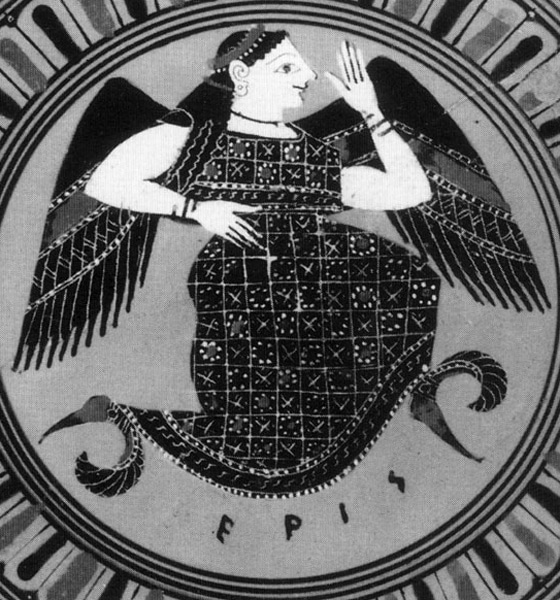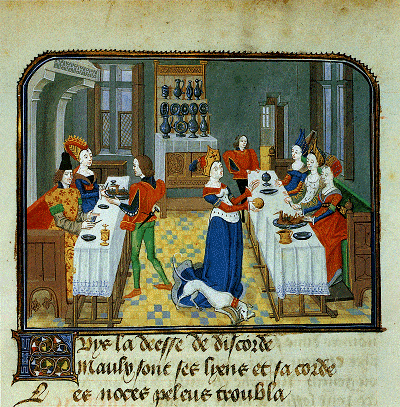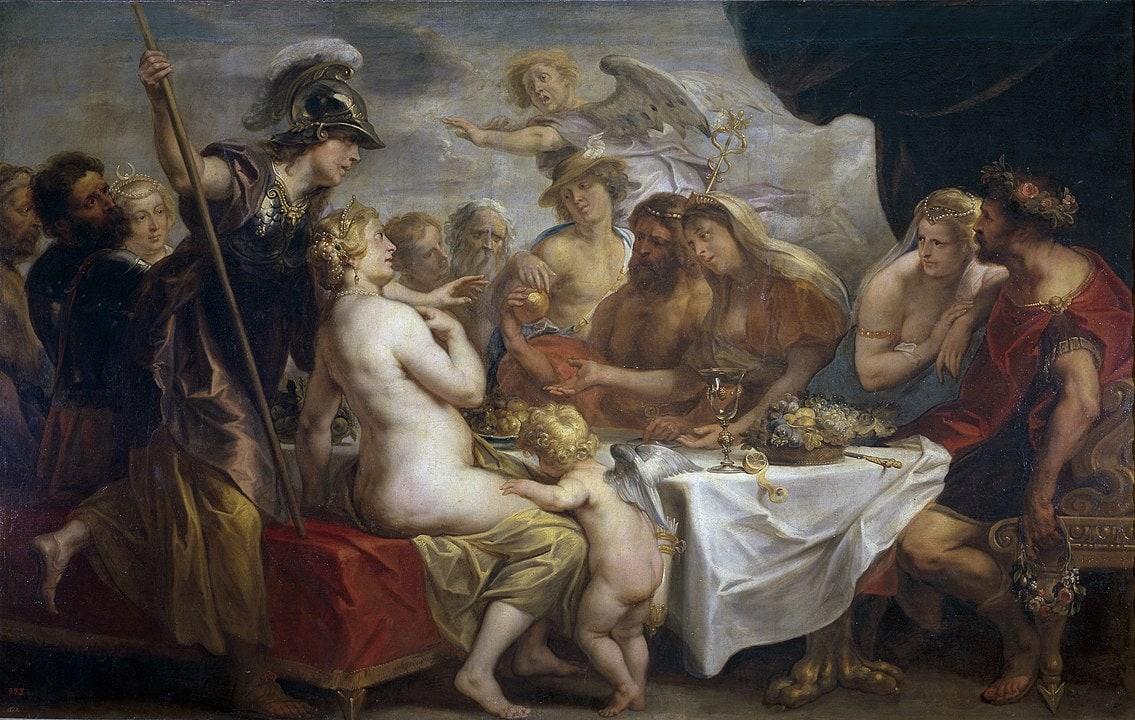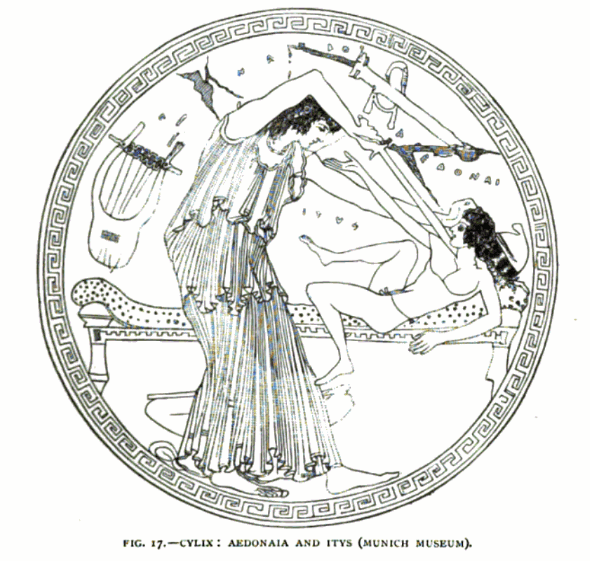
Table of Contents
In Greek mythology, Eris was the goddess of strife, rivalry and discord. She was the opposite of the goddess Dike and Harmonia and was often equated with Enyo, the goddess of war. Eris would cause the smallest of arguments to erupt into very serious events, that usually resulted in war. In fact, she’s best known for the role she played in indirectly starting the Trojan War which turned out to be one of the greatest historical events in Greek mythology.
Eris’ Origins
According to Hesiod, Eris was the daughter of Nyx, the personification of night. Her siblings included Moros, the personification of doom, Geras, the god of old age, and Thanatos, the god of death. In some accounts, she’s referred to as the daughter of Zeus, the king of the gods, and his wife Hera. This makes her the sister of the war god, Ares. Some sources say that Eris’ father was Erebus, the god of darkness, but in most cases her parentage remains disputed.

Eris is usually depicted as a young woman, a positive force of the creation of chaos. In some paintings, she’s portrayed with her golden apple and a xiphos, a one-handed, double-edged shortsword, whereas in others, she’s depicted as a winged goddess. Sometimes, she’s portrayed as a woman in a white dress with dishevelled hair, symbolizing chaos. She represented negative reactions and emotions that people wanted to avoid.
Eris’ Offspring
As mentioned by Hesiod, Eris had several children, or ‘spirits’ known as the Cacodaemons. Their role was to plague all of mankind. The identity of their father is unknown. These children were:
- Lethe – the personification of forgetfulness
- Ponos – the personification of hardship
- Limos – the goddess of starvation
- Dysnomia – the spirit of lawlessness
- Ate – the goddess of ruinous and rash actions
- Horkos – the personification of a curse inflicted on anyone who swears a false oath
- The Makhai – the daemons of battle and combat
- The Algae – the goddesses of suffering
- The Phonoi – the gods of murder
- The Androktasiai – the goddesses of manslaughter
- The Pseudologoi – the personifications of lies and wrong doings
- The Amphilogiai – the female spirits of altercations and disputes
- The Nelkea – the spirits of arguments
- The Hysminai – the daimones of combat and fighting
Eris’ Role in Greek Mythology
As the goddess of discord, Eris was often found alongside her brother Ares, on the battlefield. Together, they delighted in the suffering and pain of soldiers and encouraged both sides to continue fighting until one side was victorious. Eris took great joy in making small arguments become big ones that finally resulted in bloodshed and war. Making trouble was her specialty and she managed to make it wherever she went.
Eris loved watching the arguments of others and whenever people feuded, argued or bickered, she was in the middle of it all. She created discord in marriages, causing distrust and disagreement between couples so that over time the love would be lost. She could make people resent someone else’s good skills or fortune and was always the first to instigate any argument. Some say that the reason for her unpleasant character was the fact that her parents Zeus and Hera were always fighting, distrusting and disagreeing with each other.
Eris was viewed as a harsh goddess who enjoyed unhappiness and turmoil and although she never took sides in any argument, she happily witnessed the suffering of every person involved in it.
The Wedding of Thetis and Peleus
One of the most famous myths featuring Eris took place at the wedding of Peleus, the Greek hero, to Thetis, the nymph. It was a lavish affair and all the deities were invited, but because the couple didn’t want any strife or discord to occur at the wedding, they didn’t invite Eris.

When Eris discovered that a wedding was taking place and that she hadn’t been invited to it, she was outraged. She took a golden apple and wrote the words ‘to the fairest’ or ‘for the most beautiful one’ on it. Then, she turned up at the wedding even though she hadn’t been invited and tossed the apple among the guests, mostly towards the side where all the goddesses were sitting.
At once, her actions caused discord among the wedding guests for the apple came to rest near three goddesses who each tried to claim it as her own, believing that she was the fairest. The goddesses were Hera, the goddess of marriage and Zeus’ wife, Athena, the goddess of wisdom and Aphrodite, the goddess of love and beauty. They began to argue about the apple until Zeus finally brought forward Paris, the Trojan Prince, to select the fairest of them and solve the issue.
The goddesses tried their best to win Paris’ decision and they even tried to bribe him. Athena promised him infinite wisdom, Hera promised to give him political power and Aphrodite said she would give him the most beautiful woman in the world: Helen of Sparta. Paris was tempted by Aphrodite’s promise and he decided to award the apple to her. By doing so, he doomed his home, the city of Troy, in the war that soon ensued by stealing Helen away from Sparta and from her husband.

Therefore, Eris had certainly lived up to her reputation as the goddess of strife. She set the events in motion that let to the Trojan War. During the war, Eris was said to have stalked the battlefield with her brother, Ares, although she never participated herself.
Eris, Aedon and Polytekhnos
Another tale of Eris includes the love between Aedon (the daughter of Pandareus) and Polytekhnos. The couple claimed to be more in love than Zeus and Hera were and this angered Hera, who didn’t tolerate such things. To take revenge on them, she dispatched Eris to wreak discord and strife upon the couple and the goddess set to work.
Once, Aedon and Polytekhnos were both busy, each trying to finish a task: Aedon was weaving a web and Polytekhnos was finishing a chariot board. Eris appeared on the scene and told them that whichever one finished their task first would gifted a female servant by the other. Aedon won, by finishing her task first, but Polytekhnos wasn’t happy to be defeated by his lover.
Polytekhnos came up to Aedon’s sister, Khelidon, and raped her. Then, he disguised Khelidon as a slave and gave her to Aedon as her female servant. However, Aedon soon found out that it was her own sister and she was so angry with Polytekhnos that she chopped his son to pieces and fed the pieces to him. The gods were displeased when they saw what was going on, so they turned all three of them into birds.

Worship of Eris
Some say that Eris was feared by the ancient Greeks and Romans who regarded her as the personification of everything that posed a threat to the neat, well-run and orderly cosmos. Evidence shows that there were no temples dedicated to her in ancient Greece although Concordia, her Roman counterpart, had several in Italy. It can be said that she was the least popular goddess in Greek mythology.
In Brief
As the daughter of the night, Eris was one of the most disliked goddesses in Greek religion. However, she was a powerful goddess who played an important role in lives of the people since every single argument, big or small began and ended with her. Today, Eris is remembered not for any great myths about her, but as the personification of the rivalries and grudes that started the greatest war in Greek mythology.








